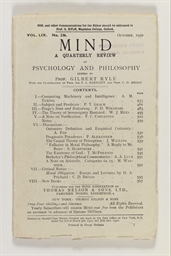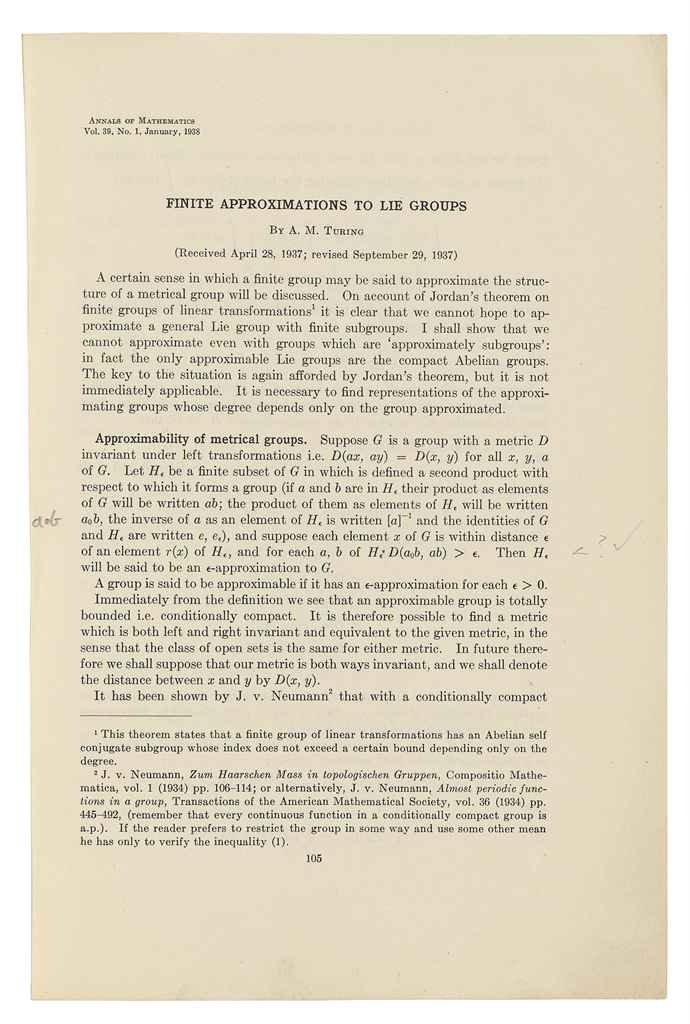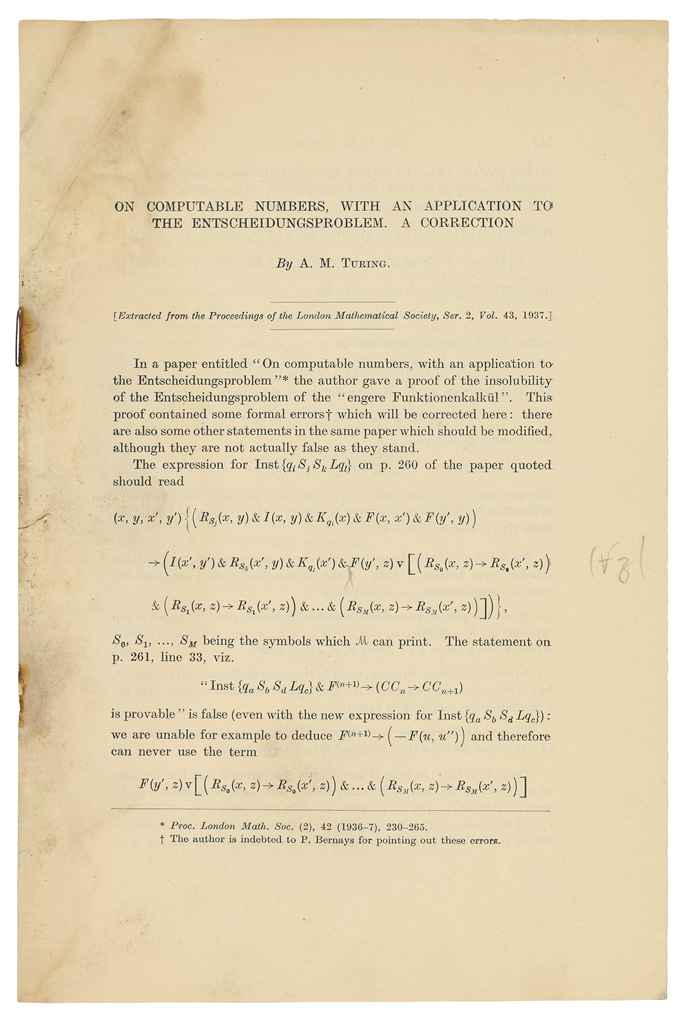TURING, Alan Mathison (1912-1954). "On computable numbers, with an application to the Entscheidungsproblem ." In Proceedings of the London Mathematical Society , 2d series, 42, pt. 3 (November 30, 1936): 230-40; pt. 4 (December 23, 1936): 241-65. 4 o. Original gray printed wrappers; boxed. FIRST EDITION. Turing entered King's College, Cambridge, in 1931 and was elected a fellow of the college in 1935. In 1935 he learned from a lecture course by the Cambridge topologist Max H. A. Newman, that the so-called Entscheidungsproblem of Hilbert remained an open question. He showed a draft of the above paper to Newman at Cambridge in April 1936. Almost at the same time he learned of Alonzo Church's totally different solution of the same problem in "An unsolvable problem of elementary number theory" ( American Journal of Mathematics 58 [1936]: 345-63). The need to add an appendix to his paper, showing that his and Church's paper had reached the same conclusion through different routes, delayed submission of "On computable numbers" for publication until August. Turing's "On computable numbers" introduced the concept of a "universal machine," an imaginary computing device designed to replicate the mathematical "states of mind" and symbol-manipulating abilities of a human computer. Turing conceived of the universal machine as a means of answering the last of the three questions about mathematics posed by David Hilbert in 1928: (1) is mathematics complete ; (2) is mathematics consistent ; and (3) is mathematics decidable (see lot 117). Hilbert's final question, known as the Entscheidungsproblem , is concerned with whether there exists a definite method -- or, in the suggestive words of Turing's teacher Max Newman, a "mechanical process" -- that can be applied to any mathematical assertion, and which is guaranteed to produce a correct decision as to whether that assertion is true (Hodges 1983, 91). The Czech logician Kurt Gödel had already shown that arithmetic (and by extension mathematics) was both inconsistent and incomplete. Turing showed, by means of his universal machine, that mathematics was also undecidable. To demonstrate this, Turing came up with the concept of "computable numbers," which are numbers defined by some definite rule, and thus calculable on the universal machine. These computable numbers "would include every number that could be arrived at through arithmetical operations, finding roots of equations, and using mathematical functions like sines and logarithms -- every number that could possibly arise in computational mathematics" (Hodges 1983, 100). Turing then showed that these computable numbers could give rise to uncomputable ones -- ones that could not be calculated using a definite rule -- and that therefore there could be no "mechanical process" for solving all mathematical questions, since an uncomputable number was an example of an unsolvable problem. Turing's idea of a "universal machine" was given the name "Turing machine" by Church. A few months later Emil Post, working independently of Turing, published his "Finite combinatory processes -- formulation 1," which described an automaton almost exactly like a Turing machine. Turing spent from September 1936 to 1938 at Princeton University, where he studied with Alonzo Church, and came into contact with John von Neumann. Concerned about what he perceived was an inevitable war with Germany, in 1937 Turing built an electromechanical cryptanalysis machine to multiply binary numbers in a Princeton machine shop -- an early confirmation of his parallel interests in both the theory of computing and its expression in concrete devices. In 1938 he returned to Cambridge. The following year he designed an analog machine to calculate the Riemann zeta-function, and also worked on an analog tide-predicting machine. On September 4, 1939, one day after England declared war with Germany, Turing reported to the Government Code and Cypher School at Bletchley Park. There, as part
TURING, Alan Mathison (1912-1954). "On computable numbers, with an application to the Entscheidungsproblem ." In Proceedings of the London Mathematical Society , 2d series, 42, pt. 3 (November 30, 1936): 230-40; pt. 4 (December 23, 1936): 241-65. 4 o. Original gray printed wrappers; boxed. FIRST EDITION. Turing entered King's College, Cambridge, in 1931 and was elected a fellow of the college in 1935. In 1935 he learned from a lecture course by the Cambridge topologist Max H. A. Newman, that the so-called Entscheidungsproblem of Hilbert remained an open question. He showed a draft of the above paper to Newman at Cambridge in April 1936. Almost at the same time he learned of Alonzo Church's totally different solution of the same problem in "An unsolvable problem of elementary number theory" ( American Journal of Mathematics 58 [1936]: 345-63). The need to add an appendix to his paper, showing that his and Church's paper had reached the same conclusion through different routes, delayed submission of "On computable numbers" for publication until August. Turing's "On computable numbers" introduced the concept of a "universal machine," an imaginary computing device designed to replicate the mathematical "states of mind" and symbol-manipulating abilities of a human computer. Turing conceived of the universal machine as a means of answering the last of the three questions about mathematics posed by David Hilbert in 1928: (1) is mathematics complete ; (2) is mathematics consistent ; and (3) is mathematics decidable (see lot 117). Hilbert's final question, known as the Entscheidungsproblem , is concerned with whether there exists a definite method -- or, in the suggestive words of Turing's teacher Max Newman, a "mechanical process" -- that can be applied to any mathematical assertion, and which is guaranteed to produce a correct decision as to whether that assertion is true (Hodges 1983, 91). The Czech logician Kurt Gödel had already shown that arithmetic (and by extension mathematics) was both inconsistent and incomplete. Turing showed, by means of his universal machine, that mathematics was also undecidable. To demonstrate this, Turing came up with the concept of "computable numbers," which are numbers defined by some definite rule, and thus calculable on the universal machine. These computable numbers "would include every number that could be arrived at through arithmetical operations, finding roots of equations, and using mathematical functions like sines and logarithms -- every number that could possibly arise in computational mathematics" (Hodges 1983, 100). Turing then showed that these computable numbers could give rise to uncomputable ones -- ones that could not be calculated using a definite rule -- and that therefore there could be no "mechanical process" for solving all mathematical questions, since an uncomputable number was an example of an unsolvable problem. Turing's idea of a "universal machine" was given the name "Turing machine" by Church. A few months later Emil Post, working independently of Turing, published his "Finite combinatory processes -- formulation 1," which described an automaton almost exactly like a Turing machine. Turing spent from September 1936 to 1938 at Princeton University, where he studied with Alonzo Church, and came into contact with John von Neumann. Concerned about what he perceived was an inevitable war with Germany, in 1937 Turing built an electromechanical cryptanalysis machine to multiply binary numbers in a Princeton machine shop -- an early confirmation of his parallel interests in both the theory of computing and its expression in concrete devices. In 1938 he returned to Cambridge. The following year he designed an analog machine to calculate the Riemann zeta-function, and also worked on an analog tide-predicting machine. On September 4, 1939, one day after England declared war with Germany, Turing reported to the Government Code and Cypher School at Bletchley Park. There, as part





.jpg?w=400)




.jpg)

.jpg?height=400)
.jpg)

Try LotSearch and its premium features for 7 days - without any costs!
Be notified automatically about new items in upcoming auctions.
Create an alert